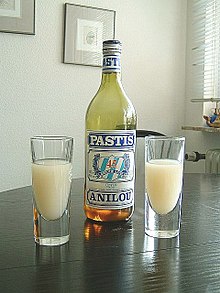Pastis
Pastis (from the Provencal pastís 'mixture' ) is a spirit made from aniseed in France and typically contains 40 to 45 percent alcohol by volume . The basic ingredient was originally aniseed. But mostly the star anise from China and Vietnam is used. Other ingredients include sugar , fennel seeds , liquorice roots , various other herbs (such as thyme, sage, mugwort, savory, cumin, centaury), water and alcohol.
history
Pastis is a typical French schnapps that is particularly widespread in the south of France . In fact, it is a relatively recent development. In March 1915, the production, distribution and consumption of the thujone- containing herbal spirit absinthe and similar spirits such as aniseed liqueurs were banned. In Provence, farmers secretly produced a substitute for the banned absinthe. Its name comes from the Occitan word pastís , or from the French pastiche , which means 'imitation'. It was not until 1922 that it was legally recognized in France that aniseed liqueurs, unlike absinthe, were harmless except for alcohol and were therefore allowed again. The alcohol content in France was originally limited to 30 % by volume . In 1922 the permitted content was increased to 40% by volume and in 1938 to 45% by volume.
Flavoring with plant extracts can be carried out according to Regulation (EEC) No. 1576/89 - as with other spirits with aniseed - using various methods:
- Mashing (French macération ) or distillation ,
- Renewed distillation of the alcohol with the addition of seeds or other parts of the (initially mentioned) plants,
- Addition of natural distilled extracts from anise plants,
- Combination of the three aforementioned methods.
Other natural plant extracts or seeds are allowed as long as the aniseed taste remains predominant. A spirit may only be called pastis if it contains natural extracts from liquorice (Glycyrrhiza glabra) in addition to the plant extracts mentioned . The glycyrrhizic acid content must be at least 0.05 grams per liter and must not exceed 0.5 grams per liter. Pastis must not contain more than 100 grams of sugar per liter. Its anethole content must be between 1.5 and 2.0 grams per liter.
Serve
Pastis is traditionally drunk with (ice) water (5–6 parts water to one part pastis). The resulting dilution ensures that essential oils previously dissolved in the alcohol become insoluble. The color of the actually dark yellow to bronze colored schnapps turns into an opalescent, milky white yellow ( louche effect ). The yellow color of undiluted pastis is due to artificial coloring. There are also colorless pastis. Individual manufacturers such as Distillerie Janot also have blue variants in their range.
Variations
In addition to mixing with water, it can also be prepared as a long drink with cola , bitter lemon , champagne or orange juice .
Another variant, especially popular in the south of France, is adding a dash of syrup or liqueur to the pastis, which is served with water and ice, and adds a touch of color as well as flavor. Pastis with green mint syrup, for example, are referred to as “Perroquet” (parrot), pastis with red grenadine syrup as “tomato” and pastis with milky white almond milk syrup as “Mauresque” ( Maurin ).
Brands
In addition to the two large, industrially produced brands Ricard and Pastis 51, there are a number of smaller commercial producers, e.g. B. Duval , Casanis , Berger , Un Marseillais or Henri Bardouin . Most of them are distilleries that produce liqueurs and their pastis or aniseed aperitifs in addition to the brandies . The success of these distilleries has encouraged the large producers to offer upscale variants in addition to their standard products.
About the Pernod : It's an aniseed aperitif, but not a pastis. Because to be called that, it has to be flavored with liquorice - a spice that Pernod lacks.
Pastis de Marseille
As Pastis de Marseille Pastis is called with its own characteristics, which distinguishes it clearly from other varieties. The anethole content is two grams per liter, the minimum alcohol content is 45% vol. The permissible use of flavoring substances and extracts also differs.
Pastis in the kitchen
Pastis is suitable for use with soups and other dishes. The German food stylist Stevan Paul writes about the use of pastis in cooking: "Tomato soups suddenly taste unimaginably refined, fried porcini mushrooms with a splash of pastis turn out sensationally, it is indispensable to round off fish stocks and fish soups."
See also
Similar aniseed schnapps in the Mediterranean area :
- Ouzo in Greece
- Rakı in Turkey and the Balkans
- Arak in Lebanon and Syria
- Masticha in Southeast Europe
- Sambuca in Italy
Web links
- Stevan Paul: Amber to clouds of fog: Pastis, the elegant intoxication for those who know the limits, s. https://nutriculinary.com/2009/04/02/bernstein-zu-nebelwolken-pastis-der-elegante-rausch-fur- Grenzenenkenner/ (last accessed on August 6, 2018)
